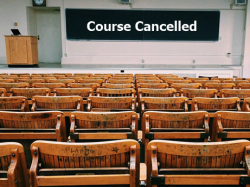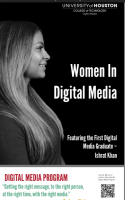A Deborah Corn Interview with Andy & Julie Plata
The University of Houston Digital Media Program’s Reinvention
Edited for brevity and clarity

 D: We are talking to Julie and Andy Plata. I'm excited to speak to you today about the University of Houston's digital media program. First, let's give everyone an overview of what the program is and how you came to be involved in it.
D: We are talking to Julie and Andy Plata. I'm excited to speak to you today about the University of Houston's digital media program. First, let's give everyone an overview of what the program is and how you came to be involved in it.
A: The University of Houston took the initiative to reinvent how they were presenting print because graphic arts education at the university level is shrinking and dying very quickly in North America. The reason is, students don't think print, and they don't want to get involved in print programs.
 So, the university took the initiative to redefine its graphic arts program to attract students with interests in eMedia, video, photography, or gaming with courseware encompassing eleven communication components, which included print.
So, the university took the initiative to redefine its graphic arts program to attract students with interests in eMedia, video, photography, or gaming with courseware encompassing eleven communication components, which included print.
Julie and I have been privileged to provide over 150 scholarships to students around the world. Through those students, we saw that the education they were receiving was often time not pertinent to today’s digital media environment.
So, we wanted to find a way to make a difference, and we found that way by volunteering as advisors to the University of Houston's Digital Media Program.
The reason we think this program is innovative is that rather than teaching students to be specialists in one media - print, social media, photography, or video - it teaches across eleven media platforms. So, when they graduate, they can help their employers or clients determine what mix of media will help them most effectively convey their message.
Very few other people know how to do that vital task of cross-media management. So those students are highly employable when they graduate.
 J: The university describes their teaching discipline as transmedia. They understand that you must get the right message to the right person at the right time, using the right media. So, students learn how to build websites, how to use social media like Twitter and Facebook and LinkedIn. Moreover, they are proficient in visual media like photography, videography, print, and packaging.
J: The university describes their teaching discipline as transmedia. They understand that you must get the right message to the right person at the right time, using the right media. So, students learn how to build websites, how to use social media like Twitter and Facebook and LinkedIn. Moreover, they are proficient in visual media like photography, videography, print, and packaging.
They learn how to design programs for publication across multiple media platforms. This knowledge eliminates the dilemma of creating a beautiful print piece that you later discover doesn't look very good on the website or Facebook. By learning transmedia design, students can design campaigns for seamless publication across multiple platforms.
Rather than just being pigeonholed in one aspect of a campaign, with no concept of what happens when a project leaves their desk, these transmedia students provide employers a broader understanding of the project’s success components.
D: I couldn't agree with you more, and I love that they're teaching them to create for all the different platforms and ways that information can also be transferred too because that is something that doesn't always get communicated.
Did the university come to you and ask you to help? Did you solicit them? Like where is that step that you said, we're the Platas, and we're here to help you?
J: For years we've heard printers say we're all getting older, where's the youth? Millennials were not applying for print-related jobs, and graphic arts programs at universities were declining or closing. In response, we began seeking university programs capable of attracting digital-native millennials with courseware relevant to today’s digital media environment.
That quest led us to the University of Houston, a Carnegie-designated Tier One public research university. We were impressed with the faculty’s commitment to modernize their program by integrating print courseware with the full array of multi-media disciplines. As a result, we joined their advisory board to better understand the objectives and needs of the Digital Media Program.
A: Our objective was to understand what was needed to transition graphic arts into a full transmedia program. Once we gained that understanding, we made a list of companies with products that we felt could help maximize the Program’s success. We then set a goal to invite their participation in the Program.
| Transmedia: Messaging designed for seamless publication across multiple media disciplines to deliver the right message to the right people, at the right time, on their platform(s) of choice. |
D: In the University’s materials and website, Xerox and XMPie and other print-related companies are playing a significant role in this program. Can you share how you got them involved, and how are they supporting, specifically?
 A: The transmedia messaging objective required students to design campaigns for seamless publication across multiple media disciplines to deliver the right message to the right people, at the right time, on their platform(s) of choice. However, it was a challenge to accomplish that objective without sophisticated cross-media software.
A: The transmedia messaging objective required students to design campaigns for seamless publication across multiple media disciplines to deliver the right message to the right people, at the right time, on their platform(s) of choice. However, it was a challenge to accomplish that objective without sophisticated cross-media software.
From our experience, we felt XMPie’s powerful cross-media software would serve the University’s transmedia objective. When we explained the University’s transmedia goals to XMPie’s president and founder, Jacob Aizikowitz, he quickly agreed to donate software. That software is a critical part of the courseware for highly personalized, interactive messaging across multiple media platforms.
J: With XMPie, students can design and execute personalized and individualized print, packaging, design, and social media. XMPie fits perfectly into the Program because students can use it across the various media platforms.
D: How is the curriculum being developed to make sure the students come out of this program with real-world skills and knowledge to get work?
A: That question has three answers – guidance, software, and expertise. The Digital Media Program’s Advisory Board includes 35 digital media professionals who meet with the faculty every three months to consistently define and refine courseware and Program objectives.
Also, students need a consistent flow of information from industry professionals with expertise in one or more of their various areas of study. Since the classrooms have projection screens, the best subject experts from around the world are invited to join a professor, via the web or in person, and share their passion for and knowledge of a specific topic.
Companies like Xerox/XMPie, ESKO, EFI, Kodak, OutputLinks Communications Group, and EKI Interactive have already donated software and expertise to the program. As the Program moves forward, new digital media companies will be invited to participate in developing the next generation’s print industry workforce.
| The enthusiastic response to the University’s reinvention of graphic arts education required a new campus in 2016. With continued growth, an additional building opened in September 2019. |
D: And what sort of jobs can they get after graduation?
J: Next to cybersecurity graduates, the Digital Media Program is recognized for having the highest employment rate after graduation. With the unique capability to produce, manage, and execute across multiple disciplines, employers value the students’ skills.

One example is a 2018 graduate who was hired to fill a specific media need. But because of her ability to produce messaging for seamless publication across multiple platforms, she now supervises a team of five. That's an excellent tribute to the Program’s effectiveness.
Other graduates have been hired by print, design, packaging, photography, and video production companies.
A: Graduates have also informed new employers how products they used in at the University may be of benefit to campaigns they are working on. An example is a 2019 graduate who has already recommended XMPie software to six clients of the PR firm that hired her. Students know how the donated products helped in their projects, and they're passing that information onto their new employers. The result is a Win-Win scenario for students and donors. As more companies realize measurable revenue potential from their donations, we can expect donations to increase dramatically.
 D: I would dare to say that the purpose of the program is to be relevant, and this sounds like a relevant one. There are some programs out there that are teaching the students a pretty outdated curriculum. I love this program as it gives the students real-world skills, and there are cases to prove it. I mean, they're working, and they're thriving.
D: I would dare to say that the purpose of the program is to be relevant, and this sounds like a relevant one. There are some programs out there that are teaching the students a pretty outdated curriculum. I love this program as it gives the students real-world skills, and there are cases to prove it. I mean, they're working, and they're thriving.
D: Do you have a special connection to the University of Houston that led you there?
A: We have a home in Houston, our companies are headquartered there, and I have a mathematics degree at the University. But it was the University’s Win-Win Program that led us to volunteer there. We felt that for a program to be a long-term success, the donor companies needed to see the potential for revenue gain. And this Program does that through an innovation Public-Private Partnership System.
J: The goal is to develop a case study related to the University’s success in reinventing their graphic arts degree program to share with other universities around the world to help them energize and reinvent their print-related degree programs.
Students share their digital media experiences in this short student-produced video
D: I love the step and repeat strategy. That's genius. I would like to end this podcast by asking how our listeners can get involved and support the University of Houston's Digital Media Program.
A: Information of that type is available at AmericanPrinter.com/PMC as well as contact information to the Digital Media staff. The page also has excellent videos of students sharing how what they learned will carry over to their careers. Also, there is information for those wanting to join the Program as advisors or donors.
J: Printers often complain that “Millennials are anti-print and are not coming into the industry.” My suggestion is rather than just complaining, let’s all invest time and resources to help change those misconceptions.
We have seen students come into the Digital Media Program wanting to study gaming, videography, or social media. However, when they see how individualized print technology can empower their campaigns, their negative perceptions about print change, and they get hooked on print.
So, review the Program materials at AmericanPrinter.com/PMC. Ask the Digital Media staff or us any questions you like and then go duplicate in your area what the University of Houston has done to reinvent graphic arts education. Just do it!
 D: And I'm going to amen what you just said there, Julie. Every print shop, manufacturer, and supplier can help ensure the print industry’s next-generation workforce by learning form this Program.
D: And I'm going to amen what you just said there, Julie. Every print shop, manufacturer, and supplier can help ensure the print industry’s next-generation workforce by learning form this Program.
To hear the entire podcast, tune into PODCASTS FROM THE PRINTERVERSE
For More INFORMATION On the Digital Media Program




Prefer to comment without registration? Click in the Name field and select "I'd rather post as a guest"